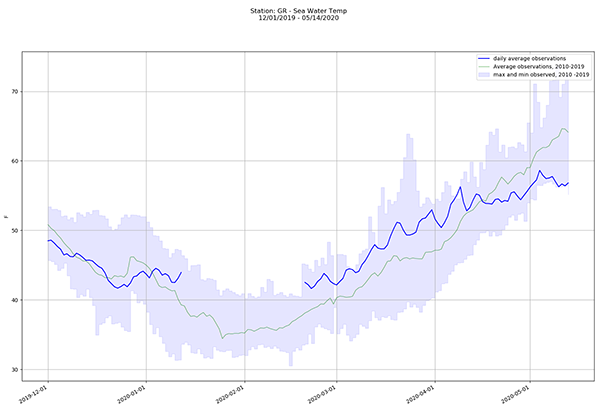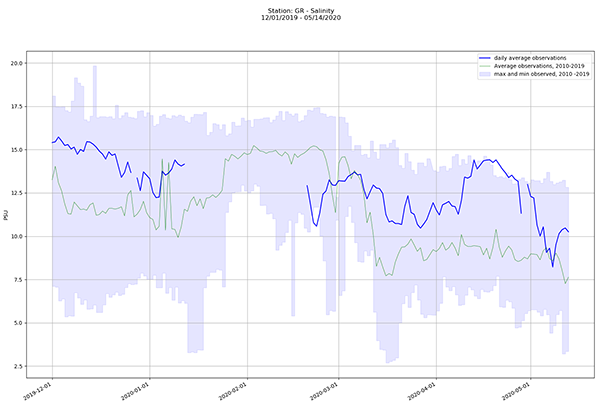Much of the 2019-20 winter was warmer than average. That translates into water temperatures running a few degrees higher than average for the winter, too. Water temperature ran two or three degrees above average for much of late winter. But recent weeks have trended cooler. What does that mean for Bay species who use the water as habitat?
This graph shows water temperature at the CBIBS Gooses Reef buoy from December 1, 2019, through the end of April 2020. The blue line shows the average daily temperature for that time period; the green line is the average daily temperature there for December-April ever since the buoy was deployed in 2010.

Salinity was also a bit higher than average for parts of the winter. But salinity levels can change quickly if there is a large precipitation event or a few weeks of dry weather. Even the higher salinity is still within the range seen at the Gooses Reef CBIBS location during the same December-April time period since the buoy was deployed back in 2010.

What do slightly warmer water temperatures and slightly higher salinities mean for some of our favorite Bay species, like blue crab and striped bass?
Blue Crabs
In preparation for winter, blue crabs burrow into the mud at the bottom of the Chesapeake to protect themselves from cold temperatures. But every year, even having taken that safety step, a number will die due to the conditions. How severe the winter is can affect the number that die--called “overwintering mortality.”
Warmer water temperatures over the past winter may have led to fewer deaths in the blue crab population. Science will soon let us know for sure. We will learn more about the health of the blue crab population later in May, when Maryland and Virginia release the results of their annual blue crab winter dredge survey. (UPDATE: Maryland and Virginia released 2019 winter dredge survey results on May 21, 2020.) This survey tracks crab population numbers and makeup (male/female, age) at 1,500 randomly selected sites around the Bay. The samples are taken December-March, so the data were collected before COVID-19 affected researchers’ ability to work together out in the field.
Data from the winter dredge survey, along with past and recent year harvest numbers and other information, will be used by the Chesapeake Bay Stock Assessment Committee as they develop their annual Blue Crab Advisory Report to help states manage the blue crab fishery.
Striped Bass
Each spring, anglers take to the waters of the Chesapeake Bay to catch striped bass--or rockfish--the top recreational sportfish in the Bay. Chesapeake Bay spawning and nursery areas, like the Choptank River, produce most of the East Coast’s migratory striped bass. Delaware River and Hudson River also contribute significantly to the population.
Striped bass migrate up into the Bay’s rivers each spring to spawn, and the timing of when they make that trip--as well as the success of any eggs that are laid--can be affected by water temperature and water flow.
Recent research indicates that cold, wet winters--leading to colder water temperatures and higher freshwater flow into the Bay’s tributaries--lead to better conditions for striped bass production success. Increased freshwater flow into creeks and rivers, resulting from runoff from rainfall, leads to lower salinity levels.
When striped bass eggs hatch into larvae (usually in May), those larvae eat zooplankton. So for success, the larvae and zooplankton need to be in the same place at the same time. High water flows push nutrients into the water, which fuels the growth of phytoplankton and zooplankton. And cooler temperatures could help the timing of when the zooplankton are available match up with when the eggs hatch--if it warms too quickly, the zooplankton “bloom” could occur and be gone before the larvae are hatched and ready to eat.
While the graph suggests that salinity has been slightly higher than average and recent water temperatures just above average--and so the population might be affected--we just don’t know how much effect this small difference will have. Recent studies indicate could negatively affect striped bass. Conditions affecting the rockfish spawn and zooplankton bloom can change quickly. We’ll have to wait for fish stories from our angler friends!


